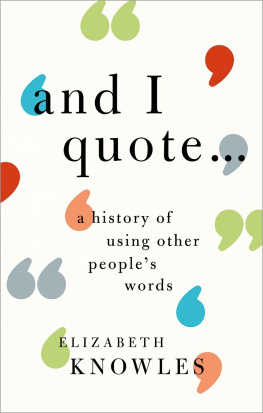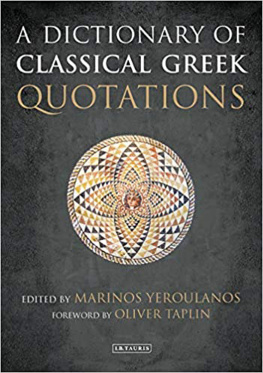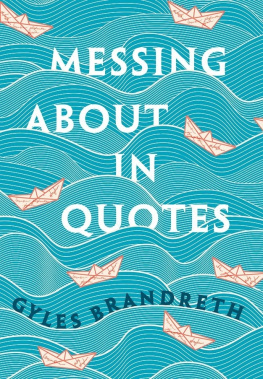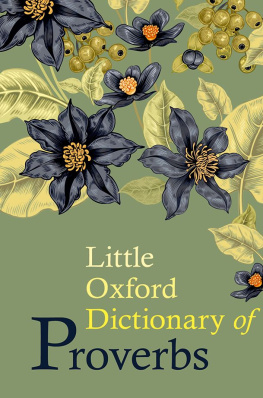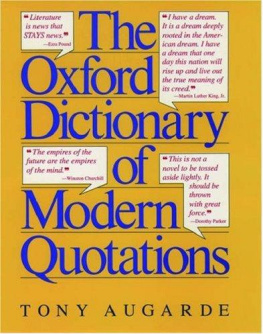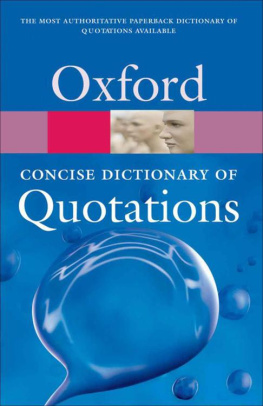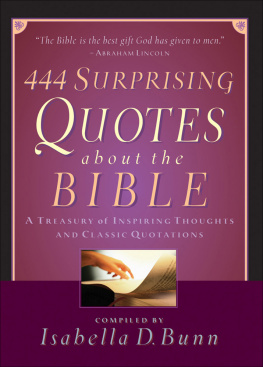And I Quote

Great Clarendon Street, Oxford, ox 2 6 dp , United Kingdom
Oxford University Press is a department of the University of Oxford. It furthers the Universitys objective of excellence in research, scholarship, and education by publishing worldwide. Oxford is a registered trade mark of Oxford University Press in the UK and in certain other countries
Elizabeth Knowles 2018
The moral rights of the author have been asserted
First Edition published in 2018
Impression: 1
All rights reserved. No part of this publication may be reproduced, stored in a retrieval system, or transmitted, in any form or by any means, without the prior permission in writing of Oxford University Press, or as expressly permitted by law, by licence or under terms agreed with the appropriate reprographics rights organization. Enquiries concerning reproduction outside the scope of the above should be sent to the Rights Department, Oxford University Press, at the address above
You must not circulate this work in any other form and you must impose this same condition on any acquirer
Published in the United States of America by Oxford University Press 198 Madison Avenue, New York, NY 10016, United States of America
British Library Cataloguing in Publication Data
Data available
Library of Congress Control Number: 2017959955
ISBN 9780198766759
ebook ISBN 9780191079368
Printed and bound in Great Britain by Clays Ltd, Elcograf S.p.A.
Links to third party websites are provided by Oxford in good faith and for information only. Oxford disclaims any responsibility for the materials contained in any third party website referenced in this work.
Preface
The genesis of the book has been my experience of working with quotations, especially in my role as Editor of the Oxford Dictionary of Quotations. My professional life as a historical lexicographer began as a library researcher for the OED Supplement, using the resources of the Bodleian library to search for earlier (and sometimes later) instances of words and phrases under consideration for inclusion in the Supplement. When subsequently I began to work specifically with quotations, I realized that the techniques needed to research and understand the way in which words and phrases develop in the language were also appropriate to understanding what can happen when a quotation becomes part of the personal or public vocabulary. Many quotations have their own stories, and these stories in turn illuminate the ways in which (consciously or unconsciously) we may quote. In this book I have focused particularly on quotations being used today, and many of my selections are taken from items encountered in the course of my work as an editormost recently, for the eighth edition of the Dictionary (published 2014).
An essential feature of this book will be tracking in detail the language history of individual quotations through specific case studies. We all have an individual vocabulary of quotations: it is likely that in many cases readers will have their own examples to illustrate the general points made, but I hope that this will only add to the interest of following selected stories. The instances in this book have in the main presented themselves through usage evidence and my own work on ODQ. The choice has been a personal one: something specific about a particular item has caught my attention. A different person might make a different choice, but I hope he or she would recognize the principles on which my choice was made to be valid. And, undoubtedly, for a future book I would make some different selections: the world of quotations constantly updates itself, and there is always another trail to follow, and another story to unpack.
elizabeth knowles
Oxford
March 2018
Acknowledgements
In writing And I Quote I have drawn on the work of fellow lexicographers at Oxford University Press. I am particularly grateful to my former colleagues Susan Ratcliffe, whose work has contributed so much over the years to the excellence of the Oxford Dictionary of Quotations, and Ben Harris, who generously read and commented on earlier versions of the text. I have learned a great deal about quotations by having the privilege of working with outside editors and consultants for Oxford Quotations dictionaries, especially the late Sir Antony Jay, Peter Kemp, and Lord Hennessy of Nympsfield. My editors at OUP have been supportive and encouraging.
It has been extremely enjoyable to work on this book, retracing and discovering individual quotation stories, and I hope I have been able to share some of that pleasure with my readers.
Material from the Oxford University Press Archives appears with the permission of the Secretary to the Delegates. Material in that has previously appeared in Dictionaries: Journal of the Dictionary Society of North America appears with the permission of the Society.
Contents
quotation, n. 5a A passage quoted from a book, speech, or other source; (in modern use esp.) a frequently quoted passage of this nature.
(Oxford English Dictionary, 3rd edn; entry updated June 2008)
Despite the certainty of the OEDs definition, quotation can be a fluid term, as a number of studies attest.), quotation is sometimes used to include both family sayings such as When in doubt tell the truth and Dont expect life to be fair, and established phrases and idioms, such as as poor as a church mouse. However, quotation in terms of the Oxford Dictionary of Quotations, and as used in this book, represents an individual expression, in speech or writing, coined by a particular person at a particular time, even though we may now not know the details of authorship or first source. As such it differs from the broad stock of proverbs and sayings, which represent common wisdom, and the range of idiomatic phrases that have developed in the language from specific quotations. No boundaries are absolute: an established quotation may develop virtual proverbial status, or give rise to a related phrase. One of the purposes of this book is to examine the way in which this form of development takes place, and explore the links that can be traced between individual items.
Quotations are part of the fabric of the language. We are often highly conscious of them: coverage of significant events and people is frequently marked by a clustering of related quotations, often from diverse sources. The most successful quotations, which have a demonstrable longevity and are still with us today, are those that were originally unique to a particular time, place, or person (real or fictional), but that have a quality of universality that means that they can offer the perfect expression in response to another place, person, or circumstance. Frequently, of course, they may be used in a sense differing from their original context, or be subject to wordplay or natural processes of language change in which one or more vocabulary items may be changed or replaced. Such developments are often a core part of a quotations usage historythat is, the record of how, in what contexts, and in what form, a particular item has been quoted through a significant chronological period of years. (The concept of currency through a timeline is not always straightforwardtoday an Internet search for a particular string may retrieve the digitized version of a nineteenth- or twentieth-century text along with contemporary uses. How readily, in such circumstances, will older sources be distinguished by the reader?)

